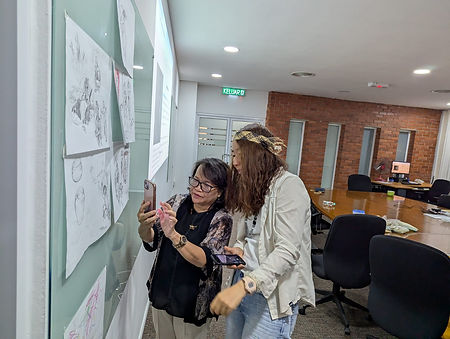Kayan Language Legacy Project
Folktales
LUNG
This page is a collection of Kayan short stories.
Lasan avan lung tam Kayan aleng anih.
Lung kelese' Ebau Alik kenan Amei Wan Jau, men Lung Bemang, Apoh, Tutoh, Baram.
This recording of the 'lung' - story telling by (Amei) Wan Jau from Long (Lung) Bemang was part of the documentation of the Kayan oral tradition project in February 2022 that involved women from the Kayan women association, Doh Kayan Telang Usan (DKTU). Here, they formed a circle in front of the story teller to recreate similar situation in which Kayan children in the past would gather around their grandfather to listen to his stories.
Anih lung en Amei Wan Jau na jaka' hadui kalo' Doh Kayan Telang Usan bulan dua duman 2022 dih. Telikin dalo' tinih, avin nunih nah daha' nyam nelikin sepui tam menuna' jaka' daha' kelenghi lung men sepun tam.
This is a story about Ebau Alik, considered as a naïve man, a bit of a simpleton. Yet, he was a man who saw not the worst in people, and whose demeanor always brought the best in them.
Lung marung Ebau Alik anih. Lake' em nuno' nyemungen, bi sayu tebara aleng deng tam belajen men lung anih. En tam petmei kah urip tam ja em piyah selanguk Ebau Alik.

Mo' Ya (Paya Wan) telling the story of Semang
A similar character among the Uma Beluvuh Kayan is Semang, who was known for his foolishness. Like Ebau Alik in many Kayan folktales, Semang's story serves as a reminder that regardless of who we are or our status, we should always be respectful and compassionate. These values are central to our Kayan culture.
Daha' men Uma Beluvuh te' kah lung aleng piyah lung Ebau Alik nih, lung Semang kurin daha'. Lake' selangok lim kah Semang nih, bi deng lim kah itam belajen men leti lung dawa' anih. Kelunan em ngemugen kah bi te' avan tam belajen, en tam ala ket aleng sayu men lung besa' anih. Barik tam hayu ha' nyepida kenep dahin pepasi ji dahin ji.
Semang tey mese'
This story of Semang was narrated by my (late) aunty Mok Ya (Paya Wan)
Lung Semang by Paya Wan (2014)
Te' nah Semang, te' nah daha’ doh.
"Semang tey telo mese'" ken dalo' doh atih. Bo tey nah daha’ mese'.
"Eh, tey kui sengit aring" ken Semang.
Tey nah iha' sengit.
Selap lan pah Semang nih. En na' ala nah ta’in na' tih; "na upet pese' kui anih" ken na' nah ji’ek.
Bi dure' ha' te' ken lung areh. En na' upet nah ta’in na' nan, en na' lenyoh nah.
En na' seng pesek nah pese' nan dih, beka' usi te’ masik ga' pese' na'.
Te' nah daha’ aleng upet haleng atih, bei kahum lan nah kelan daha'.
“Te' ga' pese' ka' yah Semang?” ken daha’ men iha'.
“Usi te’ kelak” ken Semang.
“Ket nun im upet du Semang?” ken daha’. “Bei…ta’in!” ken na'.
“Tey nah telo kap Semang, te' uro anih, ja telo mesek mese' tinih”. “
Eh, bu ta’e!” ken daha’.
Te' nah daha’ bah ji, “eh, bu ta’e!” ken daha’ atih pah.
“Bei na nun telo bu ta’e nih du Semang?” ken daha’ doh tih.
"Bah, nun im upet dido?” ken daha’ meteng iha' la'an. “Bei, ta’ik kah didu”, ken na'.
“Ani! Ani! nah Semang, usi jadi nunan, en telo ngaham haruk” ken daha’.
Tey nah daha’ kap bahe', daha’ ala bag daha’ tih, daha’ ngahem nah haruk. Ngapueh nah bu atih.
Daha’ pango apui, uh anan iha' nah daha’ kuman.
Uh kuman anan, “tey nah telo ajen Semang” ken daha’.
Im uk ha' upet ken daha’. Daha’ ih nah iha' upet. Iha' nah iha' ala masik.
Tey uli nah telo Semang ken daha’. Usi te' piyan kelak kahum ken nah pah.
Jima telo ney ajen ken daha’ men iha'. Iha' nah daha’ uli.
Do malah tey pah daha’ ajen.
Semang, tey nah im ngale’ haleng, ja si ika' em upet ta’e ken daha’.
Jah, ken na'. Iha' nah iha' ngale' haleng. Ha' nah daha’ tey ajen.
Bo, kahum nah masik kelan na' ken daha’ tih.
Iha' nah te' ajen uk kelan na'.
English translation:
(Once upon a time) there was Semang and there were some young girls. One day, the girls asked Semang to go fishing. "Semang, let's go fishing" they said. So they went.
But before they went, Semang told the girls he wanted to ease himself. "Eh, let me ease myself first!" said Semang.
He was quite a strange man. He foolishly thought that his poop would be good as bait for fishing. So after he was done, he collected his poop and brought it along as bait.
Semang sat at the back while the girls sat in front of their boat. When they had found a good place to fish, the girls took their fishing rod and used earthworms as their bait. Semang took his poop, meshed it and placed it around his hook as his bait.
He waited and waited but he did not catch any fish.
Meanwhile, the girls who used earthworms as bait had caught a lot of fish.
Semang placed some more poop as his bait and tried again hoping to catch fish. Yet again, no fish took to his bait.
“What do you use for bait, Semang?” the girls asked.
“Oh, I used my poop!” he replied. "Oh no Semang!" they exclaimed in shock.
A while later, the girls asked Semang to pull the boat to the side of the river. But when they moved to the right side of the boat, they smelled a horrible smell coming from Semang’s side. And when they moved to the left, the smell was as horrible too. They asked Semang again what he used for bait, and again he told them it was his poop.
“Oh Semang!” the girls exclaimed. “That is not the way to bait fish. We better turn the boat over to clean it” they said.
The girls collected their things and they turned the boat over to clean it. They cleaned it until the smell was gone. They then went to the river bank to build fire. They cooked the fish that the girls had caught.
After they had eaten, the girls said to Semang, “We will go again to fish, but you will use our bait”.
Semang took their bait and he was able to catch some fish.
“Let’s go back Semang”, the girls said after a while.
“But I haven’t got enough fish,” said Semang.
“It’s ok. We will come to fish again tomorrow”, they assured Semang.
The next day, the girls asked Semang to collect earthworms so that he didn’t have to use his poop.
“Ok”, Semang said as he proceeded to look for earthworms. With enough earthworms as bait, he was able to catch enough fish.
Lung Lebui:
a Kayan folktale collection
This project is a collaboration between Curtin University Malaysia and Research Institute for Languages and Cultures of Asia and Africa (ILCAA), Tokyo University of Foreign Studies (TUFS) and Kyushu University, under
Core Project “Description and Documentation of Language Dynamics in Asia and Africa: Toward a more In-depth understanding of the Languages and Cultures of People Living in Asia and Africa” (DDDLing).


Authors
Lung Lebui at TUFS



Roselind and Yuhki discussing Lung Lebui design at Curtin University Malaysia
Yasuka, Yuhki and Roselind in Lung Panai discussing concept for Lung Lebui

Team Lebui
The Lebui team trip to Lung Panai to meet the storyteller. In the boat with the team are Manan and Charlie